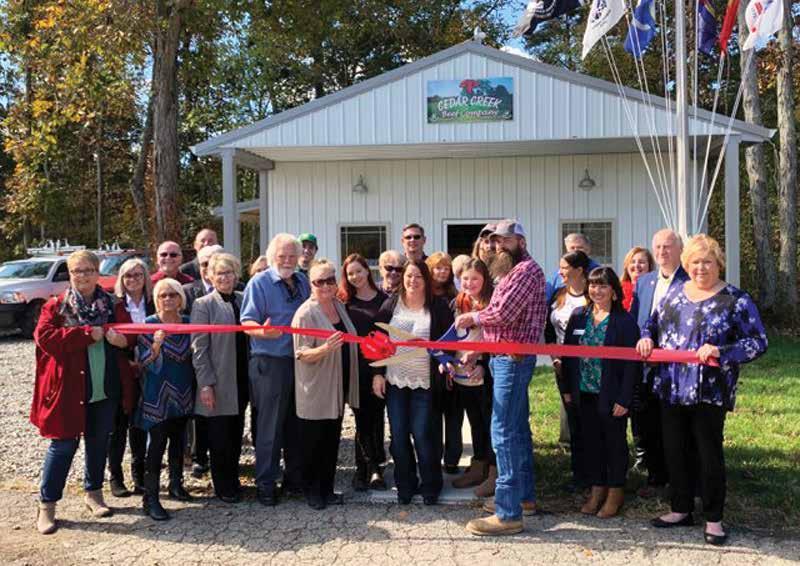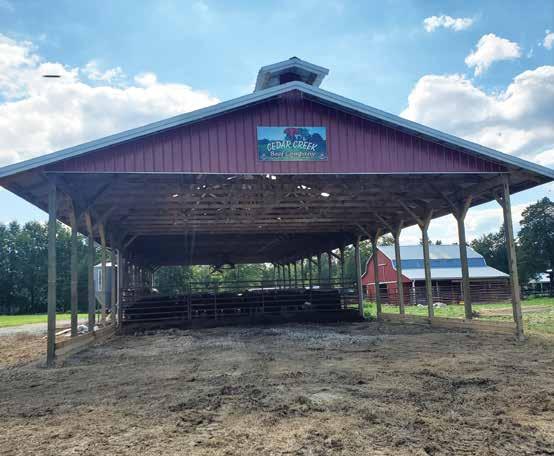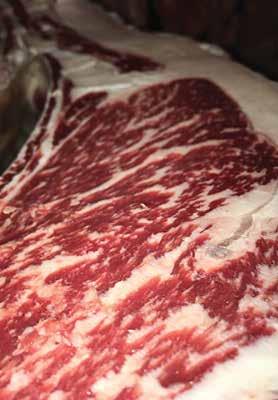
6 minute read
Cedar Creek Farms: Selling Local Santa Gertrudis Beef Quality You Can Taste
Cedar Creek Farms
Selling Local Santa Gertrudis Beef Quality You Can Taste
Emily Stribling Contributing Writer
Providing the best quality beef at a fair price has always been the mission behind Cedar Creek Farms and owner Jewett Borden, who cannot speak highly enough of the performance of his Santa Gertrudis herd. After serving in the U.S. Navy, Borden returned to his home state of Kentucky in 1997. It wasn’t long before he returned to his agricultural roots and rejoined the cattle business, as well. A few years after the dispersal of his initial cow-calf herd, a visit with a local Santa Gertrudis breeder convinced Borden to enter the business once again, but with a new breed. “I was reminded of my appreciation for eared cattle and the success we had when I was growing up,” Borden recalls. With the purchase of two purebred Santa Gertrudis heifers, his cow-calf operation was back in business. Eager to find a new outlet for his red-hided calves, Borden began finishing an average of 10 head per year, selling sides of beef to friends and family. As word spread about his local beef, interest for purchasing smaller quantities grew. “At that point, we had to make a choice to either sell beef or raise calves,” Borden says, and that’s how the storefront dream of Cedar Creek Farms began. In 2016, Borden reached out to the University of Kentucky and the Kentucky Beef Network for resources and guidance as they set out to design a finishing facility on their Shepherdsville, Ky., farm. The design started as a 40-foot by 40-foot sawdust-packed stack pad with a gravity flow feeder, a designated space for hay and water and fans for climate control. Over the last four years, they’ve grown the space to 40 feet by 120 feet, which became necessary for their increasing demand. With the help of their nutritionist, they were able to formulate a finishing ration utilizing feed sources grown locally and on the farm. Having grown up on a large farming operation himself, supporting other farmers in the community was important to Borden as he developed his operation. The careful planning proved its success when the first calves went to harvest in 2017 and 16 of the 18 graded Choice or better. “We proved the USDA graders wrong about the Santa Gertrudis breed,” Borden says. Cedar Creek has continued to have the same success with their growing Santa Gertrudis and STAR 5 herds, with 34 head grading Choice or above in 2019 and 100 head finishing Choice or above in 2020, 10 of which graded Prime. Their success on the rail, however, was not passive. Borden knew what he wanted as he grew his herd: moderate-framed cattle with a year-round calving season to meet his product demands. After inquiring why some of their cattle were not grading as well as others, “we realized we hit a genetic wall with ribeye size and marbling,” Borden says. Utilizing resources available through SGBI, he began further honing his genetics. He started focusing on ribeye area, fat and marbling, not only to improve quality grades but also the overall eating experience for Cedar Creek customers. “At the end of the day, a quality [product] we’re putting on someone’s plate is what we’re after,” Borden says. Implementing new genetics was necessary to accomplish these goals. “It was difficult for us to find exactly what we were looking for,” Borden recalls. With help from Santa Gertrudis Breeders International, he was able to purchase a new bull from Strait Ranches and looks forward to receiving the harvest data on his first calves in December 2021. Looking toward the future, they are about to begin DNA testing their herd in order to aid culling decisions on cows that aren’t progressing Cedar Creek toward their goals. They also hope to continue improving their marbling through expected progeny difference selection and evolving into a purebred Santa Gertrudis herd. Operating a storefront was not the original intention when Cedar Creek Farms began, but “as a small operation, we knew finding a niche market was necessary,” Borden says. Their operation’s development happened organically as local interest grew. “Customers enjoy seeing the operation firsthand and where their food comes from,” he says. “I spend the majority of my time at the store, educating customers and answering their questions.” Customer service and a pound of ground beef are what solidify new customers. “I’ve gained more [returning] customers off a single pound of ground beef than any steak,” Borden explains. “I ask people to do a taste test: purchase a pound of my ground beef and cook it alongside a pound from the grocery store and

taste the difference. It works every time.” While the COVID-19 era has proved difficult for many, it has further pressed the “buy local” movement. As everyday staples such as beef became sparse at local grocery stores in early 2020, consumers began turning to their local farmers and ranchers. Cedar Creek was happy to provide for their community. At the start of 2020, they were meeting their goals of growing their sales by one-third every year and were on track to eventually process 80 head per year. However, that shifted for the better as Cedar Creek sold out of all their scheduled beef for 2020 within five days in March. As demand continued to grow, however, acquiring extra space at the packer was increasingly difficult. Thankfully, a great relationship with their packer, along with purchasing calves from neighboring farms, allowed them to far surpass the 80-head goal they had set at the store’s inception, finishing/ harvesting 100 head, 85 of which were Santa Gertrudis or STAR 5. While the impacts of COVID-19 are beginning to subside, the desire for buying local is likely to continue. When asked what advice he has to offer others interested in finishing and selling local beef, Borden could not stress enough the impact that finding a quality cattle nutritionist made on his outcomes. He also suggests investing time in finding a packer that is the right fit for you. “I spent two-and-a-half months traveling the state looking for packers,” Borden says. “When you’re selling to the public, what it looks like is just as important as how it tastes. Find a packer that offers quality packaging and the cuts your customers desire.” When it comes to genetic selection, “I can’t say enough about following the genetics that get us the yields and grades we need,” he says, reminding breeders to keep the end product in mind, paying close attention to fat and ribeye area. “A few good cattle with good genetics you can grow your herd from makes the best start,” Borden says. “The more data you keep along the way, the easier it is to go back and make changes.” Borden looks forward to watching his grandchildren begin showing Santa Gertrudis cattle and hopes to one day pass Cedar Creek Farms on to the next generation . This article first appeared in the March issue of Santa Gertrudis USA.

T
Of the 100 head Cedar Creek Farms harvested in 2020. all graded Choice or higher with 10 finishing Prime
TT
Cedar Creek Finishing Facility











